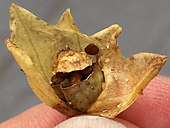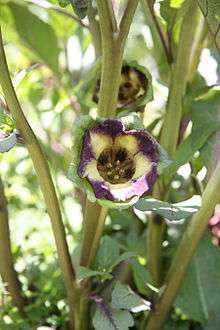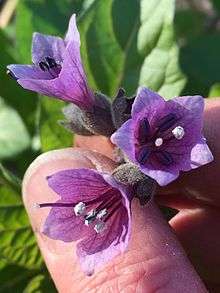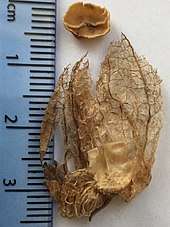Hyoscyameae
Hyoscyameae is an Old World tribe of the subfamily Solanoideae of the flowering plant family Solanaceae. It comprises eight genera: Anisodus, Archihyoscyamus, Atropa, Atropanthe, Hyoscyamus, Physochlaina, Przewalskia and Scopolia.[1] The genera Archihyoscyamus, Atropanthe and Przewalskia are monotypic, the first being endemic to Turkey and Iran,[2] the second to China and the third to Tibet.
| Hyoscyameae | |
|---|---|
| Hyoscyamus niger | |
| Scientific classification | |
| Kingdom: | Plantae |
| Clade: | Tracheophytes |
| Clade: | Angiosperms |
| Clade: | Eudicots |
| Clade: | Asterids |
| Order: | Solanales |
| Family: | Solanaceae |
| Subfamily: | Solanoideae |
| Tribe: | Hyoscyameae |
| Genera | |
| |
All eight genera of the tribe are poisonous and have a long tradition of use as medicinal plants, being rich in tropane alkaloids with anticholinergic properties.[3] Furthermore, the genera Atropa, Hyoscyamus, Scopolia and Physochlaina have furnished entheogens - the first three in the historical context of European witchcraft and, more specifically, of the flying ointments employed in such practices,[4] while the similar chemistry of the remaining genera points to the potential for entheogenic use. Six of the genera have dry, pyxidial fruits i.e. capsules dehiscing by an operculum and thus resembling a pot with a lid. The fruit of the remaining genus Atropa is a glossy, juicy berry, making Atropa species especially dangerous poisonous plants, since - unlike other Hyoscyameae - their attractive fruits may easily be mistaken for edible berries, particularly by children - as has frequently occurred in the case of Atropa belladonna, the infamous Deadly Nightshade.[5]
A ninth genus referable to Hyoscyameae remains unresolved : the poorly-known, monotypic genus Pauia contains the single species Pauia belladonna Deb and Dutta native to Assam and Arunachal Pradesh. The late Professor Armando Theodoro Hunziker, one of the foremost authorities on the Solanaceae, was of the opinion that Pauia should be subsumed in Atropa. The plant resembles the Indian Atropa acuminata, but differs from it most markedly in bearing a berry that, unlike those of other Atropa species, is not globose but oblong in shape, somewhat resembling that edible Solanaceous fruit the Goji.[6]
Gallery
- Pyxidial fruits of black henbane Hyoscyamus niger
 Anatomy of Hyoscyamus niger showing dissected pyxidium etc.
Anatomy of Hyoscyamus niger showing dissected pyxidium etc. Golden henbane Hyoscyamus aureus single flower
Golden henbane Hyoscyamus aureus single flower Hyoscyamus aureus in flower and fruit
Hyoscyamus aureus in flower and fruit- Egyptian Henbane Hyoscyamus muticus single flower interior
- Hyoscyamus muticus plant in flower and fruit
 Flower of Atropa belladonna in close-up, showing curled stamens
Flower of Atropa belladonna in close-up, showing curled stamens Atropa belladonna in fruit : ripe and unripe berries
Atropa belladonna in fruit : ripe and unripe berries- Atropa belladonna ripe berry in close-up
 Anatomy of Atropa belladonna flower and berry
Anatomy of Atropa belladonna flower and berry- Botanical illustration of Atropa baetica, Andalusian belladonna
 Scopolia carniolica: two flowers in close-up, showing unripe anthers - yet to dehisce.
Scopolia carniolica: two flowers in close-up, showing unripe anthers - yet to dehisce. Scopolia carniolica in flower
Scopolia carniolica in flower Anatomy of Scopolia carniolica , showing pyxidium etc.
Anatomy of Scopolia carniolica , showing pyxidium etc. Scopolia carniolica: fruiting calyx dissected to reveal dehiscence of ripe pyxidium.
Scopolia carniolica: fruiting calyx dissected to reveal dehiscence of ripe pyxidium. Rhizome of Scopolia carniolica
Rhizome of Scopolia carniolica- Scopolia japonica (Japanese: 走りどころ Hashiri-dokoro) in flower
- Single flower of Scopolia japonica showing dehiscence of ripe anthers
 Anisodus tanguticus, showing interior of flower
Anisodus tanguticus, showing interior of flower.jpg) Flower and foliage of Anisodus luridus
Flower and foliage of Anisodus luridus Flowers of Physochlaina orientalis
Flowers of Physochlaina orientalis_G._Don%2C_showing_pyxidial_capsule.jpg) Interior of pyxidium of Physochlaina orientalis
Interior of pyxidium of Physochlaina orientalis_G.Don.jpg) Ripe fruits of Physochlaina orientalis, showing nodding growth habit
Ripe fruits of Physochlaina orientalis, showing nodding growth habit_(8469918743).jpg) Physochlaina physaloides foliage and inflorescence
Physochlaina physaloides foliage and inflorescence Dissected fruit of Physochlaina physaloides with detached operculum
Dissected fruit of Physochlaina physaloides with detached operculum
References
- An-ming,Lu and Zhi-yu,Zhang Studies of the Subtribe Hyoscyaminae in China, paper no. 5 in Solanaceae : Biology and Systematics , Ed. William G. D'Arcy, pub. Columbia University Press 1986.
- http://www.catalogueoflife.org/annual-checklist/2014/details/species/id/16693507 Retrieved 11.03 on 31/10/18
- Peigen, Xiao and Liyi, He Ethnopharmacologic investigation on tropane-containing drugs in Chinese Solanaceous plants in Journal of Ethnopharmacology Volume 8 No. 1 July (1983) pub. Elsevier.
- Rätsch, Christian, The Encyclopedia of Psychoactive Plants: Ethnopharmacology and Its Applications pub. Park Street Press 2005
- A Colour Atlas of Poisonous Plants : A Handbook for Pharmacists, Doctors, Toxicologists, and Biologists by Frohne, Dietrich and Pfänder, Hans Jürgen of University of Kiel, translated from second German edition by Norman Grainger Bisset, London : a Wolfe Science Book and one of the volumes in the illustrated series Wolfe Atlases, pub. Wolfe Publishing Ltd. 1984.
- Armando T. Hunziker: The Genera of Solanaceae. A.R.G. Gantner Verlag K.G., Ruggell, Liechtenstein 2001. ISBN 3-904144-77-4.